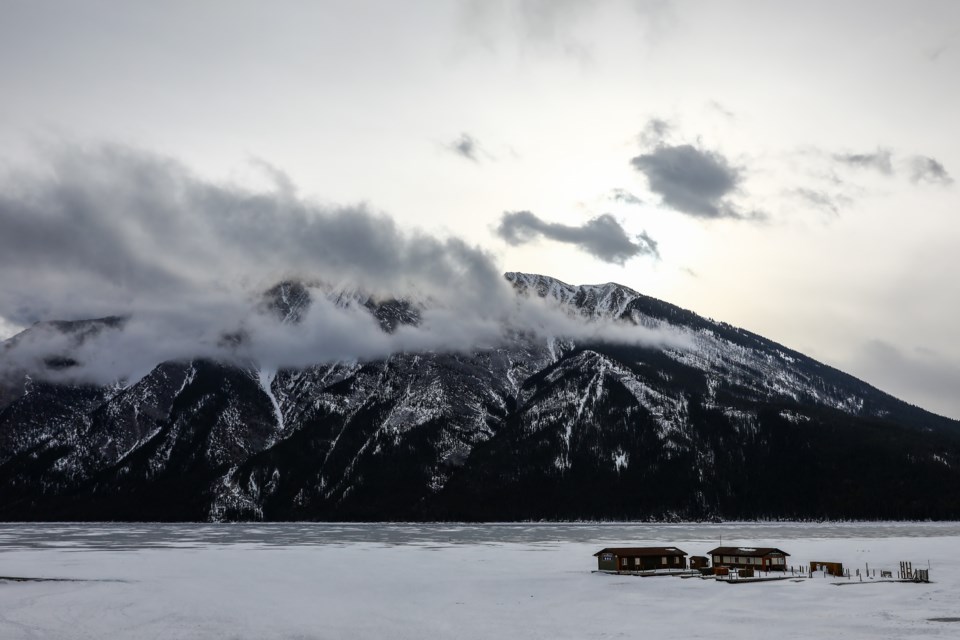BANFF NATIONAL PARK – She sits on an ice block shivering as the wind howls across the frozen lake.
As she stands up, she takes off her towel poncho. It’s 1 Celsius outside, the same temperature as the lake she is about to jump into, with only a six millimetre thick custom wetsuit to shield her from the cold water.
Lorenza Malaguti is a freediver. With few options for the Calgary-based diver to explore, she and a small group have resorted to diving in the frigid waters of Lake Minnewanka and other mountain lakes in the Canadian Rockies.
Freediving is a sport normally associated with the warm waters of Hawaii or the Caribbean, but Malaguti’s passion for the largely unknown sport has led her to practice it in extreme conditions.
“It’s excruciating. It’s not very pleasant when you’re in it. It’s so cold and you’re shivering, but when you get out it’s that feeling you get – your body just feels full of energy,” said Malaguti on the shore of Lake Minnewanka after spending the afternoon diving.
“It’s also the feeling of being at peace. There is nothing else quite like it.”
As a child, Malaguti grew up in Italy and became hooked on freediving from a young age because of her grandfather, who taught her to swim.
“My grandfather was big into the ocean and basically taught my brother and me how to swim before we could walk, and then he taught us to freedive without us even realizing it at the time.”
She continued to practise freediving as her studies took her to the Caribbean to become an emergency veterinary doctor. Malaguti regularly practised freediving in the tropical waters and fondly remembers catching lobster for dinner. After settling in Calgary, she continued the sport, making annual trips to Tofino, B.C. or to Hawaii, and four years ago started diving in mountain lakes.
Since Malaguti and her friends started diving in the Rockies, they have dove in Lake Minnewanka in the summer and winter, while using Quarry Lake and an alpine lake near Smutwood Peak in Kananaskis in the summer.
To prepare for the March 7 dive at Lake Minnewanka, Malaguti enlisted the help of friend and divemaster Brad Petty and ice diver Ryan Gateman to assist in supporting the trio of divers.
Freediving in a frozen lake is a laborious process. It starts with hauling a large amount of support gear onto the middle of the lake, to cutting a hole in the ice with a chainsaw, to hauling the large ice blocks out of the water onto the ice, just to set up for the dive.
Freediver Jamie Bigelow called it the “diving warm-up.”
To help battle the cold water, the divers wear custom-made wetsuits that range in thickness from five to seven millimetres. The suits are so thin, they can be punctured or torn by a fingernail.
Getting the suit on is a challenging process because of how tight it is to the diver's body.
“I just try to get it on as quickly as possible, it’s probably the worst part of the whole day,” said Bigelow while laughing.
To help squeeze into their suits, every diver has their own preferred method and lubricant, which can range from a water-based lubricant to a biodegradable hair conditioner.
In the past, the sport was often associated with a high death rate, but today the athletes have developed many rigorous safety measures, and Malaguti said it is rare to have a blackout while in the water. Divers are more extensively trained, they always dive with a partner, and in the case of ice diving, a rope is anchored into the ice and the divers are tethered to it, so they cannot be swept away under the ice.
“It’s not as extreme as people think; it’s actually a really neat form of meditation. It’s more mental than physical, to be honest,” Malaguti said.
Olivier Aubin started freediving five years ago in California, and said once getting into the frigid water, your body wants to go into shock. Overcoming that is the key to ice diving.
“Getting relaxed in the water and acclimatizing to the cold is key,” said Aubin. “Your body wants to breathe and building up a tolerance overtime to fight the need to breath is the only way you can freedive.”
For Bigelow, it’s all about controlling his heart rate.
“You have to learn to control your heart rate before you go down in order to be down longer. When the water is this cold it is very difficult to control that,” said Bigelow.
The past year has been a challenge for freedivers based in Calgary due to COVID-19 restrictions put in place on pools. Without access to pools, it has been difficult to train properly in water. Divers have been forced to do dryland training and run through breathing exercises.
However, that lack of training did not stop the trio from diving into Lake Minnewanka, while only 300 metres away on the surface, others were enjoying ice skating on the picturesque lake.
“It’s difficult to prepare for something like overcoming that sense of starting to shiver really quickly, and then you can’t hold your breath,” Malaguti said.
With the mix of cold and lack of training, Malaguti reached six metres on her deepest dive, staying underwater for about 15 seconds. Usually she can hit between 10 to 15 meters easily.
Despite the challenging conditions, Malaguti remained positive about the outing.
“You don’t go ice diving to hold your breath for the longest or to go the deepest you’ve ever gone. You do it for the experience,” said Malaguti.
Bigelow shared her sentiment.
“The water is beautiful, we are lucky to be blessed with such clear and clean water. The adventure of going down and then coming up and seeing the hole and then the blue sky and mountains is a truly special experience.”
Read more from RMOToday.com



